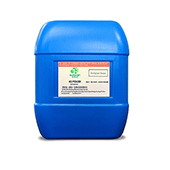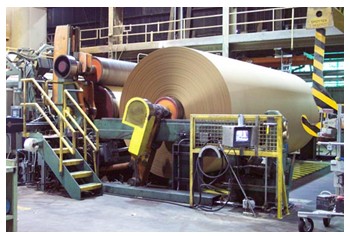
AU-PE89 Xylanase for Improved Bleaching of Paper Pulps
Xylan is a major component of wood and non-wood fibres. During cooking of pulps, the xylan is partially dissolved, modified and re-precipitate onto the fibre surface. The application of the enzyme, xylanase, to the cooked pulp removes some of the re-precipitated xylan. This opens up the pulp matrix, allowing the release of trapped soluble lignin. At the same time it allows bleaching chemicals to penetrate more effectively. The overall result is improved bleachability of the pulp with resulting reduction in usage of bleaching chemicals. AU-PE89 Xylanase is an enzyme that degrades xylan. AU-PE89 is specific for xylan and does not degrade cellulose. Xylanases produced by different microorganisms operate optimally over a range of pH and temperature. AU-PE89 was developed from a proprietary strain of bacterium for the paper pulp industry. AU-PE89 is particularly suited to the elevated temperatures and alkaline pH of kraft pulps. The manufacturing process involves growing a specific proprietary bacterium in bioreactors (fermenters), separating the cells from the broth, and concentrating the clarified liquid. The product is prepared as a concentrated liquid or light brown powder.
Details
Xylan is a major component of wood and non-wood fibres. During cooking of pulps, the xylan is partially dissolved, modified and re-precipitate onto the fibre surface. The application of the enzyme, xylanase, to the cooked pulp removes some of the re-precipitated xylan. This opens up the pulp matrix, allowing the release of trapped soluble lignin. At the same time it allows bleaching chemicals to penetrate more effectively. The overall result is improved bleachability of the pulp with resulting reduction in usage of bleaching chemicals. AU-PE89 Xylanase is an enzyme that degrades xylan. AU-PE89 is specific for xylan and does not degrade cellulose. Xylanases produced by different microorganisms operate optimally over a range of pH and temperature. AU-PE89 was developed from a proprietary strain of bacterium for the paper pulp industry. AU-PE89 is particularly suited to the elevated temperatures and alkaline pH of kraft pulps. The manufacturing process involves growing a specific proprietary bacterium in bioreactors (fermenters), separating the cells from the broth, and concentrating the clarified liquid. The product is prepared as a concentrated liquid or light brown powder.

| TECHNOLOGICAL ADVANTAGE |
| AU-PE89 acts as a pre-bleaching aid for paper pulps. AU-PE89 has specific advantages in that it is stable and active at the alkaline pH and elevated temperatures typical of kraft pulps. The main driving factors for acceptance of this technology in pulp mills have been the economic and environmental advantages over chemical bleaching. AU-PE89 used as a pre-bleaching agent for wood and non-woody pulps can reduce chemical bleach consumption from between 15 to 50%. |
| Case in China: |

We can see from the form that after using AU-PE89, wood material reduce 7.8%, water reduce 3.2%, ClO2 reduce 22.3%, NaOH reduce 28%, SO2 reduce 100%,O2 reduce 23.01%, finally pulp yield net increase 2.37%. |
| PRODUCT DESCRIPTION |
AU-PE89 is a product derived from the culture of a strain of Bacillus subtilis. The principal active ingredient of AU-PE89 is xylanase (endo-1,4-��-xylanase, EC 3.2.1.8), an enzyme that degrades and solubilizes plant xylans. AU-PE89 is prepared with a xylanase activity of about 85,000 XU/mL. The xylanase units are determined on birchwood soluble xylan at pH 6 and 50℃ over a 20 minute period. AU-PE89 xylanase is effective over the pH range 6 to 10 and temperature range 35 to 65℃
AU-PE89 is a light yellow powder with a density of 1.1 g/mL. It is readily miscible with water. |
| BENEFITS OF AU-PE89 |
Reduce Organochlorines in Wastewater: For mills using active chlorine as a bleaching chemical, AU-PE89 can eliminate or substantially reduce the chemical and environmental load of toxic organochlorines in mill effluent.
Reduce Chemical Costs: For mills using environmentally friendly bleaching agents such as hydrogen peroxide, AU-PE89 can result in a significant cost saving.
AU-PE89 has the potential to reduce bleaching chemical by15 to 50%. Increase Pulp Production Capacity: Pre-bleaching pulps with AU-PE89 allows pulp production capacity to be increased where on-site chlorine dioxide production is a limiting factor. Higher Pulp Brightness�� For a given dosage of bleaching chemical, pre-bleaching with AU-PE89 can give a higher brightness pulp, thus providing the mill with a better quality paper. AU-PE89 can increase the pulp brightness by 2 to 6%. Easily Incorporated�� AU-PE89 is easily incorporated into existing bleach lines. Typically, installation requires only a mixing tank and dosage pump. Reduce Effluent Load�� Application of AU-PE89 in the bleach plant can reduce COD, BOD and color of effluent. AU-PE89 can significantly reduce COD, BOD and color of effluent. |
| APPLICATION |
AU-PE89 xylanase can be added to pulp after cooking or oxygen delignification and prior to bleaching for the improvement of pulp bleachability. Almost every mill has unique conditions of fibre furnish, pulping technology and bleach sequence. The optimal dosage can also depend on the temperature, pH and consistency of the pulp. Application protocols for AU-PE89 can be tailored to best suit the specific process. However, the following general application optimal conditions apply.
Dosage: 200-250g/ T pulp (o.d.basis)
Pulp properties: pH between 6.5 and9.5
Temperature: between 45 and 55℃
Pulp consistency: between 6 and 10% (recommended 8%)
Residence time: above 1 hour |
| STORAGE |
AU-PE89 maintains its stated activity for at least six months when stored at temperatures below 25℃.
The product maintains its activity for considerably longer when stored at lower temperatures. The product should not be frozen. |
| HANDLING PRECAUTIONS |
| AU-PE89 is non-toxic and biodegradable. However, unnecessary contact with the product should be avoided. Long term exposure to protein based products such as AU-PE89 may sensitise certain individuals to the product |